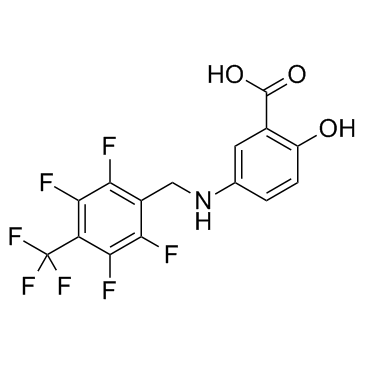| Description |
Neu2000 is an uncompetitive N-methyl-D-aspartate (NMDA) receptor antagonist.
|
| Related Catalog |
|
| Target |
NMDA receptor[1]
|
| In Vitro |
Neu2000 shows apparent neuroprotection against 300 μM N-methyl-D-aspartate (NMDA) at doses as low as 30 μM. Neu2000 does not protect cortical neurons against α-amino-3-hydroxy-5-methyl-4-isoxazolepropionic acid- or kainate-mediates excitotoxicity. Neu2000 inhibits the electrophysiologic response of cultured cortical neurons to 300 μM NMDA in a concentration-dependent manner, indicating that the effect is mediated by a specific action at NMDA receptors. The Neu2000 dose-response has an IC50 of 35.38±5.94 μM and Hill's coefficient of 0.91 (n=8). Neu2000 (100 μM) significantly reduces the maximal NMDA response by 58.31±2.72% (n=5) and the EC50 values of NMDA from 18.88±1.85 to 9.92±0.17 μM (n=5, P<0.05)[1].
|
| In Vivo |
Pharmacokinetic analysis reveals that the half-life of Neu2000 is 1.42, 2.14, and 1.79 h following intraperitoneal administration of 10, 25, and 50 mg/kg, respectively. In addition, the Cmax (maximum plasma concentration) is calculated as 3.86, 18.73, and 52.83 μg/mL and the AUC (area under the curve) is determined to be 7.37, 55.15, and 96.77 μg/h/mL at the same respective doses. The levels of basal mitochondrial ROS are significantly elevated at 24 h post-surgery in both the vehicle-treated (4.1-fold, p<0.01) and Neu2000-treated (2.9-fold, p<0.01) groups compare to sham controls. The results of blood-brain barrier (BBB) test also reveals significant changes in open field locomotion in spinal cord-injured animals treated with Neu2000 compare to vehicle-treated animals. Single (p<0.05) or repeated (p<0.01) Neu2000 treatment results in a decreased swing to stance ratio compare to vehicle-treated animals. Repeated treatment with Neu2000 results in a 45.6% decrease (p<0.01) in overall lesion volume compare to vehicle treatment, while a single administration of Neu2000 results in a 36.8% decrease (p<0.05) in overall lesion volume[2].
|
| Cell Assay |
Whole-cell voltage-clamp recordings are performed on primary cultured cortical neurons (11 to 14 DIV) at room temperature (18°C to 23°C). Whole-cell currents are recorded and analyzed using an amplifier. The 2 to 3-MΩ-resistance recording pipettes are filled with an internal solution containing 135 mM CsCl, 10 mM N-2-hydroxyethylpiperazine-N′-2-ethanesulfonic acid, 1.2 mM MgCl2, 4 mM ATP-Na2, 0.5 mM CaCl2, and 11 mM ethyleneglycol tetraacetate (pH adjusted to 7.3 with CsOH). The external solution is composed of 140 mM NaCl, 2 mM KCl, 2 mM CaCl2, 10 mM N-2-hydroxyethylpiperazine-N′-2-ethanesulfonic acid, and 0.01 mM glycine (pH adjusted to 7.3 to 7.4 with NaOH). N-methyl-D-aspartate and Neu2000 solutions are prepared by dissolving these chemicals in the external solutions, and they are applied to target neurons using a gravity-driven superfusion system with a linear array of 8 to 10 barrels. Graphing of data and dose-response analysis are performed and all data are presented as mean±s.e[1].
|
| Animal Admin |
The pharmacokinetic profile of Neu2000 in normal rats is examined using intraperitoneal (ip) route of administration. Rats are anesthetized by ether inhalation and the femoral artery cannulated. Rats are placed into cages for 1 h and then receive injections (10, 25, or 50 mg/kg ip, n=6 per dose) of Neu2000 dissolved in sterile saline. Blood is collected from the femoral artery at 15, 30, 60, 120, 240, 480, and 1440 min following injection. Plasma aliquots of 50 μL are spiked with 100 μL of internal standard solution (Neu2000IS, 10 μg/mL in acetonitrile). After vortex mixing for 1 min, the samples are centrifuged at 12,000 g for 5 min. A total of 50 μL of the supernatant phase is separated and diluted with 50 μL of distilled water. Plasma concentrations relative to time are obtained using liquid chromatography-mass spectrometry[2].
|
| References |
[1]. Gwag BJ, et al. Marked prevention of ischemic brain injury by Neu2000, an NMDA antagonist and antioxidant derived from aspirin and sulfasalazine. J Cereb Blood Flow Metab. 2007 Jun;27(6):1142-51. [2]. Springer JE, et al. The functional and neuroprotective actions of Neu2000, a dual-acting pharmacological agent, in the treatment of acute spinal cord injury. J Neurotrauma. 2010 Jan;27(1):139-49.
|
